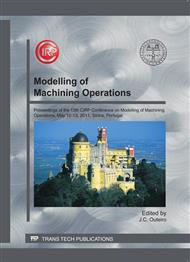[1]
B. Denkena and C. Ammermann: CA-Technologien in der Fertigungs- und Prozessplanung, in: ZWF, 104, 4 (2009), pp.300-305.
DOI: 10.3139/104.110050
Google Scholar
[2]
B. Denkena and C. Ammermann: Modular Numerical Control Model Including Realistic Motion Planning, in: The IFIP WG5.1 7th International Conference on Product Lifecycle Management (2010)
Google Scholar
[3]
Z. Yazar, K.-F. Koch, T. Merrick and T. Altan: Feed rate optimization based on cutting force calculations in 3-axis milling of dies and molds with sculptured surfaces, in: International Journal of Machine Tools and Manufacture (34) (1994), pp.365-377.
DOI: 10.1016/0890-6955(94)90006-x
Google Scholar
[4]
Y. Altintas and S.D. Merdol: Virtual High Performance Milling, in: CIRP Annals – Manufacturing Technology, 56, 1, (2007), pp.81-84.
DOI: 10.1016/j.cirp.2007.05.022
Google Scholar
[5]
P. Damm: Rechnergestützte Optimierung des 5-Achsen-Simulationsfräsens von Freiformflächen, Dissertation, Technische Universität Dortmund (2005).
Google Scholar
[6]
B. Sencer, Y. Altintas and E. Croft: Feed optimization for five-axis CNC machine tools with drive constraints, in: International Journal of Machine Tools and Manufacture, 48, 7-8 (2008), pp.733-745.
DOI: 10.1016/j.ijmachtools.2008.01.002
Google Scholar
[7]
J. Aurich, D. Biermann, H. Blum, C. Brecher, C. Carstensen, B. Denkena et al.: Modeling and simulation of process: machine interaction in grinding, in: Production Engineering, 3, (2009), p.111–120.
DOI: 10.1007/s11740-008-0137-x
Google Scholar
[8]
G. Luger and W.A. Stubblefield: Artificial intelligence – Structures and strategies for complex problem solving, Addison Wesley Longman, Harlow (1998).
Google Scholar
[9]
B. Denkena, H. Henning and L.-E. Lorenzen: Genetics and intelligence: new approaches in production engineering, in: Production Engineering, 4 (2010), pp.65-73.
DOI: 10.1007/s11740-009-0191-z
Google Scholar
[10]
G. Schuh and S. Gottschalk: Production engineering for self-organizing complex systems, in: Production Engineering, 2 (2008), pp.431-435.
DOI: 10.1007/s11740-008-0120-6
Google Scholar
[11]
K. Weinert, A. Zabel, H. Müller and P. Kersting: Optimizing of NC tool paths for five-axis milling using evolutionary algorithms on wavelets, in: GECCO '06, Proceedings of the 8th annual conference on Genetic and evolutionary computation. New York, NY, USA: ACM (2006), pp.1809-1816.
DOI: 10.1145/1143997.1144289
Google Scholar
[12]
C.-H. Chu, C.-T. Lee, K.-W. Tien and C.-J. Ting: Efficient tool path planning for 5-axis flank milling of ruled surfaces using ant colony system algorithms, in: International Journal of Production Research, (2010), pp.1-18.
DOI: 10.1080/00207540903501720
Google Scholar
[13]
K. Erkorkmaz and M. Heng: A heuristic feedrate optimization strategy for NURBS tool paths, in: CIRP Annals - Manufacturing Technology, 57, 1 (2008), pp.407-410.
DOI: 10.1016/j.cirp.2008.03.039
Google Scholar


